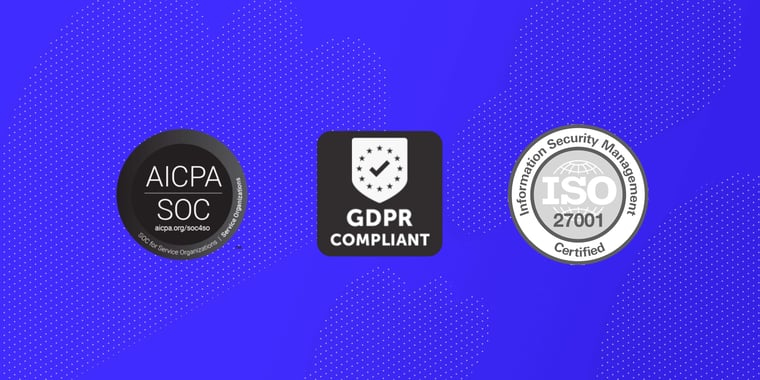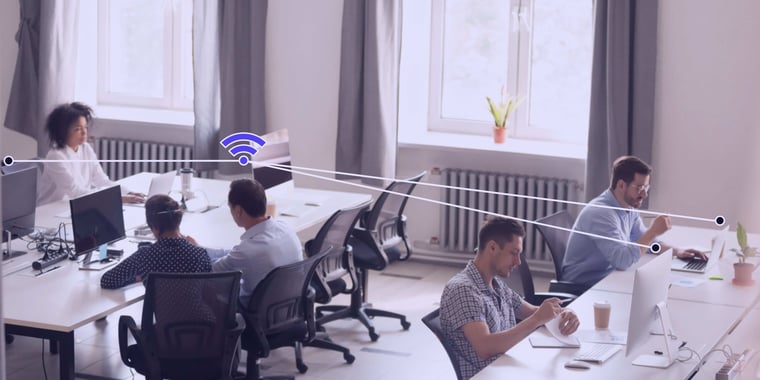How InnerSpace Prioritizes Employee Privacy With Wi-Fi
Getting you the data you need without making your teams feel over monitored
Your five-year lease is up next year, and when you look around your office, you wince, imagining having to resign for another five years with so much up in the air. It’s not that things aren’t going well. They are. Really well. Your business is growing, and you’ve come through the pandemic with clear, strategic direction to keep things going that way. The next five years will be an exciting time, you say, to your teams, who show up to company briefings both in person and via Zoom.
You know you don’t know how to compete with the couch. Your teams like working at home, and probably one of the biggest reasons for that is the flexibility to do their work on their terms, and on their own timelines. It’s also nice cutting out a commute, and working in sweatpants sometimes. You know from talking to your teams that they do like coming into the office, but they don’t want to go back to how things were. If you’re honest with yourself, you don’t either; it’s nice catching your kids’ baseball games more regularly without your commute on Wednesdays.
Things are maybe okay the way they are, you tell yourself, and then you think of that looming lease resigning, and you know you’re going have to make some big decisions about your space. You think back to competing with the couch, and one of the biggest factors that goes unsaid about why employees like working from home is privacy. Doing an analysis of your space that will be detailed enough to give you the information you need to reimagine your office in a post-pandemic climate feels invasive from the start.
Privacy: The spatial monitoring elephant in the room.
The most queries received about InnerSpace’s Wi-Fi based sensors are around privacy. Isn’t tracking employees through their Wi-Fi connected cellphones and devices kind of big brothery? My teams won’t appreciate feeling like people are monitoring them all the time, especially after years of working from home during the pandemic.
This would create a lot of trust issues with your teams. No one wants to feel like they’re being watched at work. It’s bad for morale, and office culture, and the data you get will be limited.
How InnerSpace’s space utilization data is different (and privacy safe).
We take privacy seriously, just like you do. We are GDPR compliant, and proudly meet all industry privacy standards. InnerSpace is also certified to SOC2 and ISO27001 standards. Certifying to these standards involves an independent audit confirming the security practices, policies, procedures, and operations meet or exceed standards for protecting customer information.

How it works
InnerSpace connects to your Wi-Fi access points, or APs, which are the equivalent of your router at home. Your teams also connect to your Wi-Fi when they’re in the office. We gather their signals through your Wi-Fi, which reads as a device sending a signal. We don’t know if it’s a laptop, or a phone, or a smart watch, just that a Wi-Fi enabled device is connected to your office Wi-Fi. If they have a device and don’t connect, we can still see a device, but the data is much less accurate and takes longer to provide insights on that particular device.
Through our patented algorithm, we triangulate the exact location of an anonymized employee within six feet. If you have a lot of APs, say in a bigger office, we’re better able to triangulate the data and get an even more accurate read. If a device is in two days a week, we can know that too. None of this data ever leaves InnerSpace’s systems and is completely anonymized.

AP gives us MAC address that is identifiable, but our systems anonymise it before anyone looks at it. We can tell the device is Person A, and Person A’s data becomes known to the system. But that data isn’t linked to a specific person.
As your people walk through the office, to the lunchroom, to a meeting room, or anywhere else in the office, we can begin to create insights about common pathways and behaviours, and eventually those insights deepen; InnerSpace won’t know if it’s the UX team using the board room on the third floor every Tuesday from 2pm to 4pm, but we will be able to tell you that a team is, and then you can make inferences and decisions based on that (you know that team is slated to grow, so maybe you need to make sure they have a bigger space for that meeting).
Deeper data, still privacy compliant
If you want deeper insights, we can do that too, based on the level of information you provide. APs give us MAC addresses. When you connect to Wi-Fi, it remembers the address, but we anonymize that data automatically. It’s randomized and remembered, but not as a person. It’s assigned as something that could never be identified as a human, Employee A, for example. If you want to, you can assign device a to a team, say Team B, and then look at see what Team B is doing around the office and use those insights to improve your space (Wednesdays are busy for software engineers, for example). But if that feels too invasive, you also don’t have to give us that level of information. You’ll still get best in industry insights about your space.
If a company gives us MAC addresses from the marketing team, we can tell where people are going from specific teams, but if we don’t have those, which we’d only be able to get from you, then we can’t know.

But what if an employee has a tablet, and a smart phone, and a laptop and a smart watch?
Good question! InnerSpace’s space utilization platform is always learning and can provide you with deep insights related to devices. If a device is always traveling with another device, like a smartphone and a smart watch, our sensors read it as one employee, moving in the office. If one device moves, like a phone to the lunchroom, and another, like a laptop stays at a desk, the desk space is still occupied, which is a useful insight.
Our platform is able to separate devices and avoid duplicate data better over time; it learns about habits and eventually assigns multiple devices to a single user. Person A may have a phone and a laptop, and we’ll count them as one, avoiding duplicate data and taking you beyond people counting.
Making sense of your space when you need to
InnerSpace helps you understand the total experience of your space with the hardware-less space analysis. We give you robust, useful, accurate insights into how your teams are roaming your office (for example, your marketing team does their best work lounging in the conference room they’ve turned into a relaxation zone) that you can use to make evidence-based decisions around your space.

We’re here to help you find the opportunity in every square foot. The best part? We can do this quickly with your existing infrastructure; no need for additional hardware or installation and we start providing you insights within 24 hours. No expensive, or time-consuming installs required (especially valuable if you’re not sure your current space is right for you).
You don’t want to install hardware in a space you’re not sure you want to stick with, right? And if you find it’s time to move on, we can go with you to your next space, and help you add to your story there, so you know what’s working, and what needs to evolve as your business and teams do.
Want to know more? We’d love to set up a call.
Accurate space utilization data through Wi-Fi?
We'll prove it to you.
See why industry leaders leverage InnerSpace to generate valuable insights that go beyond occupancy.

